brakes TOYOTA GR YARIS 2020 User Guide
[x] Cancel search | Manufacturer: TOYOTA, Model Year: 2020, Model line: GR YARIS, Model: TOYOTA GR YARIS 2020Pages: 458, PDF Size: 105.69 MB
Page 211 of 458
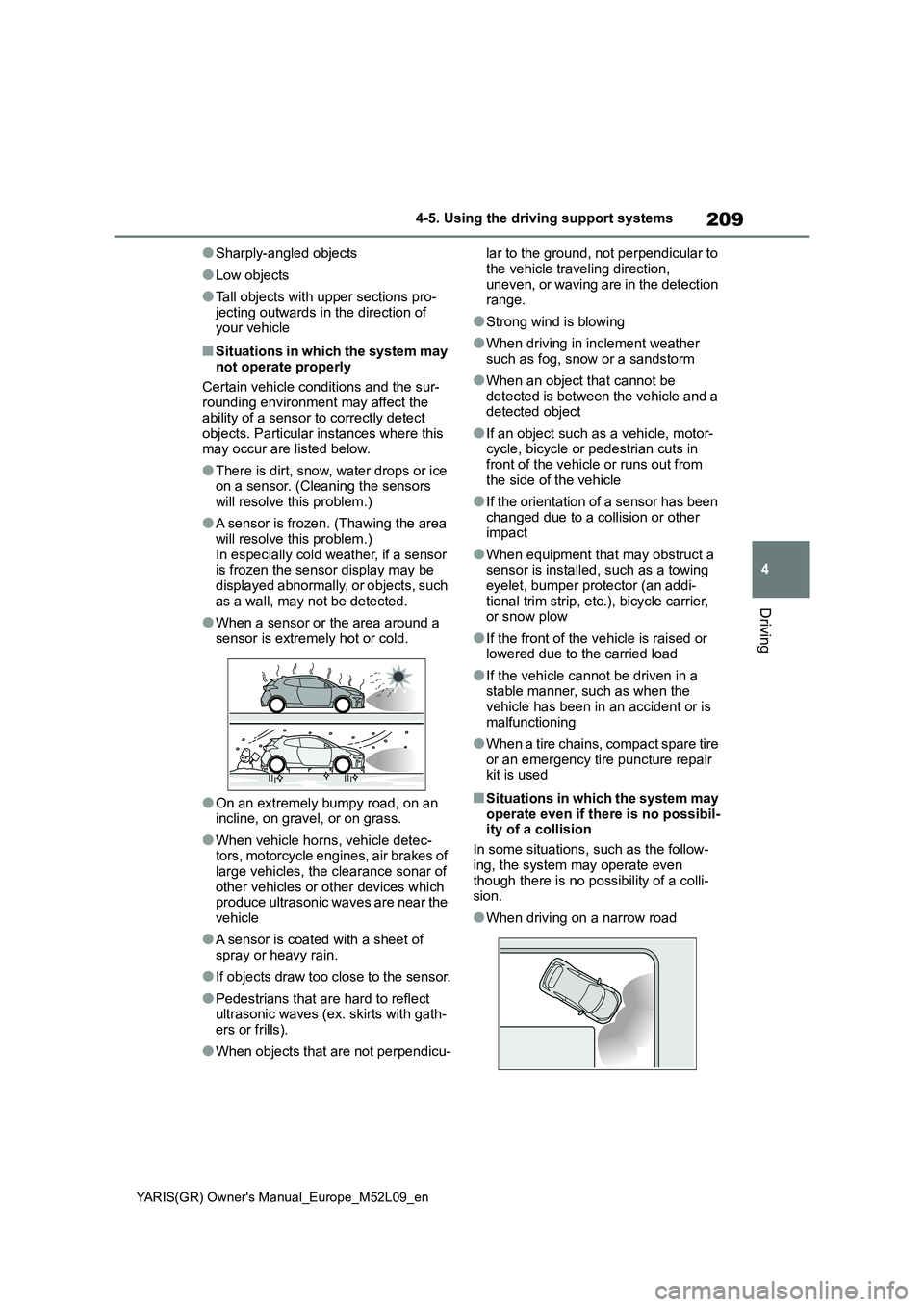
209
4
YARIS(GR) Owner's Manual_Europe_M52L09_en
4-5. Using the driving support systems
Driving
●Sharply-angled objects
●Low objects
●Tall objects with upper sections pro-
jecting outwards in the direction of
your vehicle
■Situations in which the system may
not operate properly
Certain vehicle conditions and the sur-
rounding environment may affect the
ability of a sensor to correctly detect
objects. Particular instances where this
may occur are listed below.
●There is dirt, snow, water drops or ice
on a sensor. (Cleaning the sensors
will resolve this problem.)
●A sensor is frozen. (Thawing the area
will resolve this problem.)
In especially cold weather, if a sensor
is frozen the sensor display may be
displayed abnormally, or objects, such
as a wall, may not be detected.
●When a sensor or the area around a
sensor is extremely hot or cold.
●On an extremely bumpy road, on an
incline, on gravel, or on grass.
●When vehicle horns, vehicle detec-
tors, motorcycle engines, air brakes of
large vehicles, the clearance sonar of
other vehicles or other devices which
produce ultrasonic waves are near the
vehicle
●A sensor is coated with a sheet of
spray or heavy rain.
●If objects draw too close to the sensor.
●Pedestrians that are hard to reflect
ultrasonic waves (ex. skirts with gath-
ers or frills).
●When objects that are not perpendicu-lar to the ground, not perpendicular to
the vehicle traveling direction,
uneven, or waving are in the detection
range.
●Strong wind is blowing
●When driving in inclement weather
such as fog, snow or a sandstorm
●When an object that cannot be
detected is between the vehicle and a
detected object
●If an object such as a vehicle, motor-
cycle, bicycle or pedestrian cuts in
front of the vehicle or runs out from
the side of the vehicle
●If the orientation of a sensor has been
changed due to a collision or other
impact
●When equipment that may obstruct a
sensor is installed, such as a towing
eyelet, bumper protector (an addi-
tional trim strip, etc.), bicycle carrier,
or snow plow
●If the front of the vehicle is raised or
lowered due to the carried load
●If the vehicle cannot be driven in a
stable manner, such as when the
vehicle has been in an accident or is
malfunctioning
●When a tire chains, compact spare tire
or an emergency tire puncture repair
kit is used
■Situations in which the system may
operate even if there is no possibil-
ity of a collision
In some situations, such as the follow-
ing, the system may operate even
though there is no possibility of a colli-
sion.
●When driving on a narrow road
Page 212 of 458
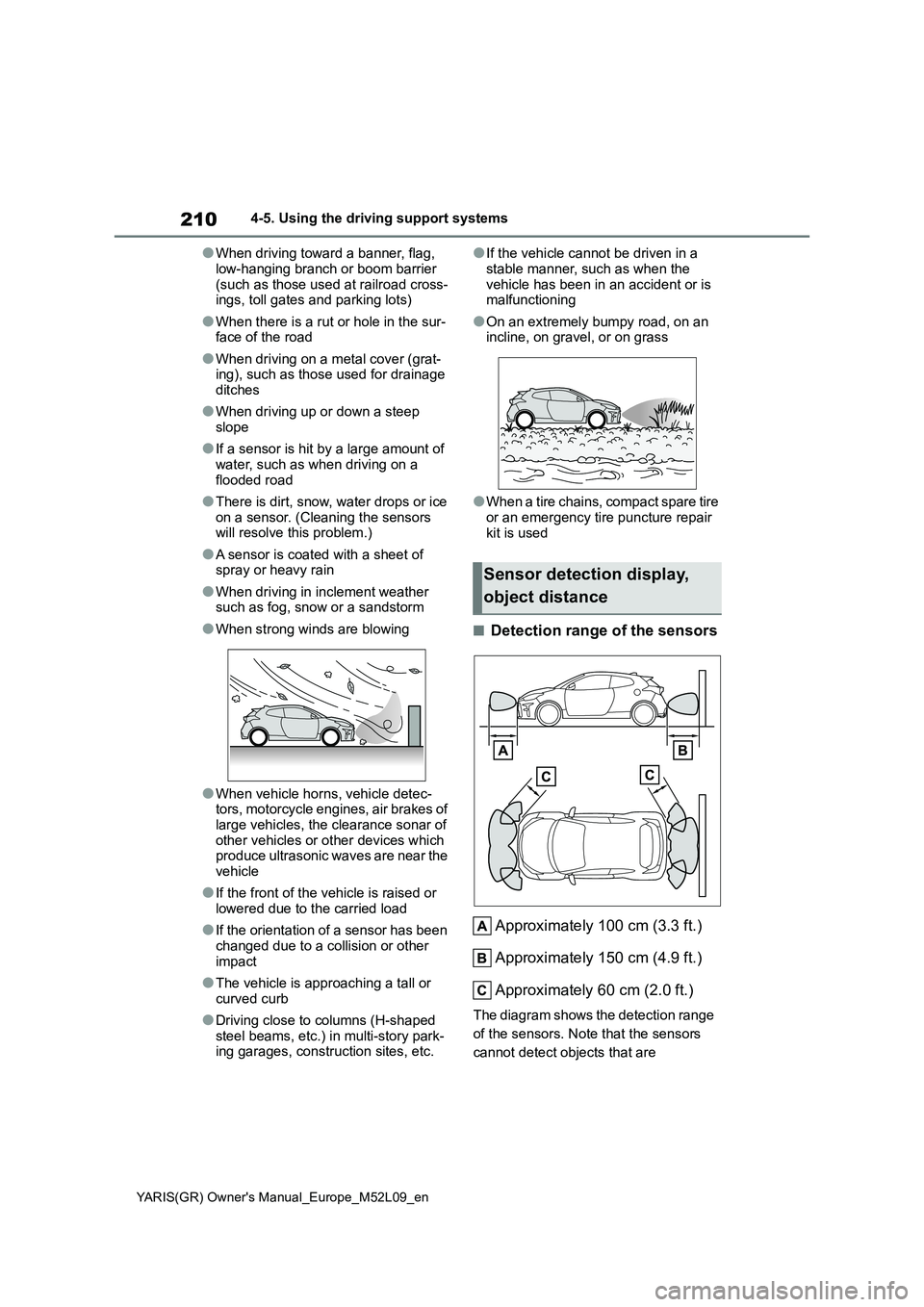
210
YARIS(GR) Owner's Manual_Europe_M52L09_en
4-5. Using the driving support systems
●When driving toward a banner, flag,
low-hanging branch or boom barrier (such as those used at railroad cross-ings, toll gates and parking lots)
●When there is a rut or hole in the sur-face of the road
●When driving on a metal cover (grat-ing), such as those used for drainage
ditches
●When driving up or down a steep
slope
●If a sensor is hit by a large amount of
water, such as when driving on a flooded road
●There is dirt, snow, water drops or ice on a sensor. (Cleaning the sensors will resolve this problem.)
●A sensor is coated with a sheet of spray or heavy rain
●When driving in inclement weather such as fog, snow or a sandstorm
●When strong winds are blowing
●When vehicle horns, vehicle detec-tors, motorcycle engines, air brakes of large vehicles, the clearance sonar of
other vehicles or other devices which produce ultrasonic waves are near the vehicle
●If the front of the vehicle is raised or lowered due to the carried load
●If the orientation of a sensor has been changed due to a collision or other
impact
●The vehicle is approaching a tall or
curved curb
●Driving close to columns (H-shaped
steel beams, etc.) in multi-story park- ing garages, construction sites, etc.
●If the vehicle cannot be driven in a
stable manner, such as when the vehicle has been in an accident or is malfunctioning
●On an extremely bumpy road, on an incline, on gravel, or on grass
●When a tire chains, compact spare tire or an emergency tire puncture repair
kit is used
■Detection range of the sensors
Approximately 100 cm (3.3 ft.)
Approximately 150 cm (4.9 ft.)
Approximately 60 cm (2.0 ft.)
The diagram shows the detection range
of the sensors. Note that the sensors
cannot detect objects that are
Sensor detection display,
object distance
Page 221 of 458
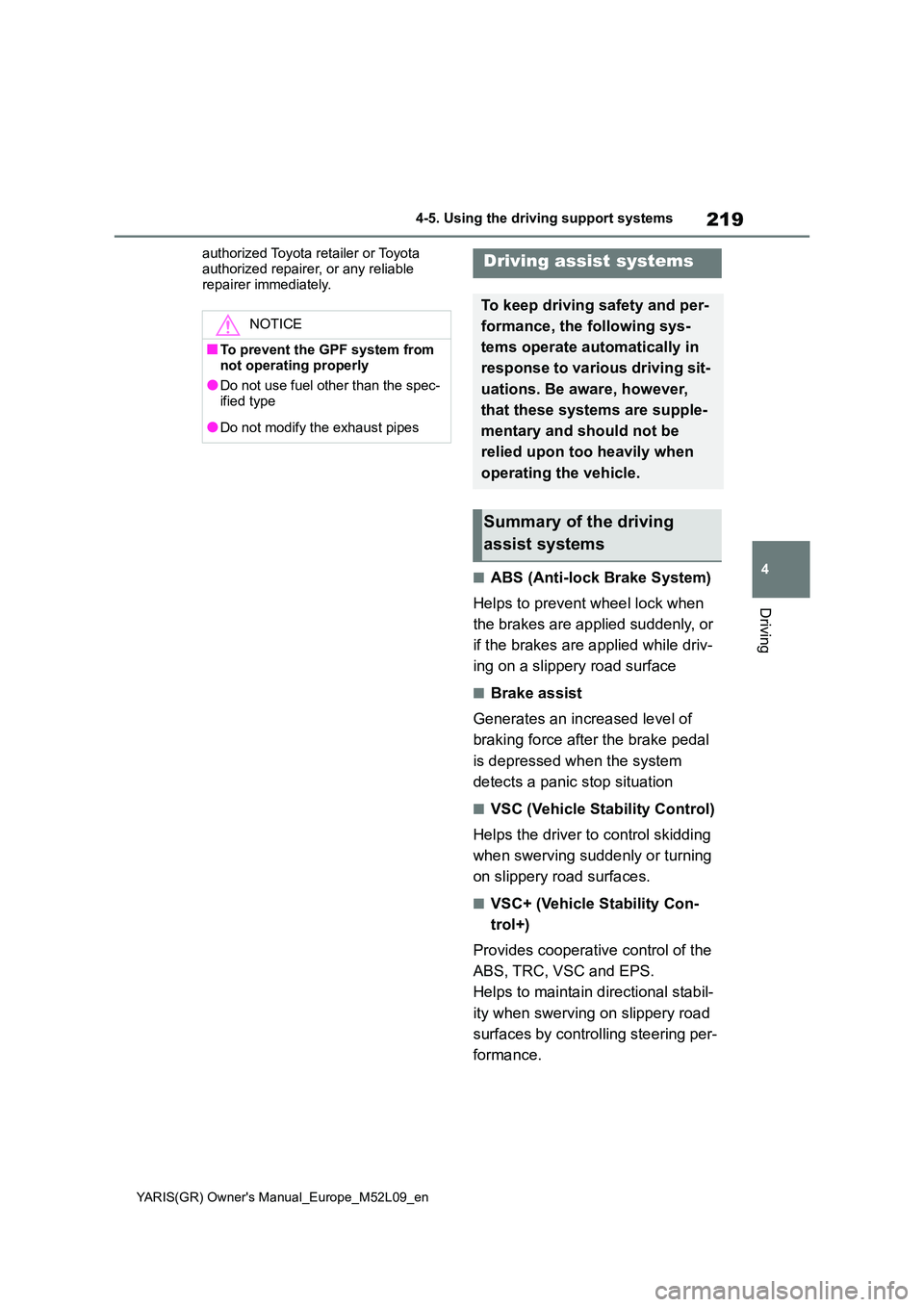
219
4
YARIS(GR) Owner's Manual_Europe_M52L09_en
4-5. Using the driving support systems
Driving
authorized Toyota retailer or Toyota
authorized repairer, or any reliable repairer immediately.
■ABS (Anti-lock Brake System)
Helps to prevent wheel lock when
the brakes are applied suddenly, or
if the brakes are applied while driv-
ing on a slippery road surface
■Brake assist
Generates an increased level of
braking force after the brake pedal
is depressed when the system
detects a panic stop situation
■VSC (Vehicle Stability Control)
Helps the driver to control skidding
when swerving suddenly or turning
on slippery road surfaces.
■VSC+ (Vehicle Stability Con-
trol+)
Provides cooperative control of the
ABS, TRC, VSC and EPS.
Helps to maintain directional stabil-
ity when swerving on slippery road
surfaces by controlling steering per-
formance.
NOTICE
■To prevent the GPF system from
not operating properly
●Do not use fuel other than the spec- ified type
●Do not modify the exhaust pipes
Driving assist systems
To keep driving safety and per-
formance, the following sys-
tems operate automatically in
response to various driving sit-
uations. Be aware, however,
that these systems are supple-
mentary and should not be
relied upon too heavily when
operating the vehicle.
Summary of the driving
assist systems
Page 222 of 458
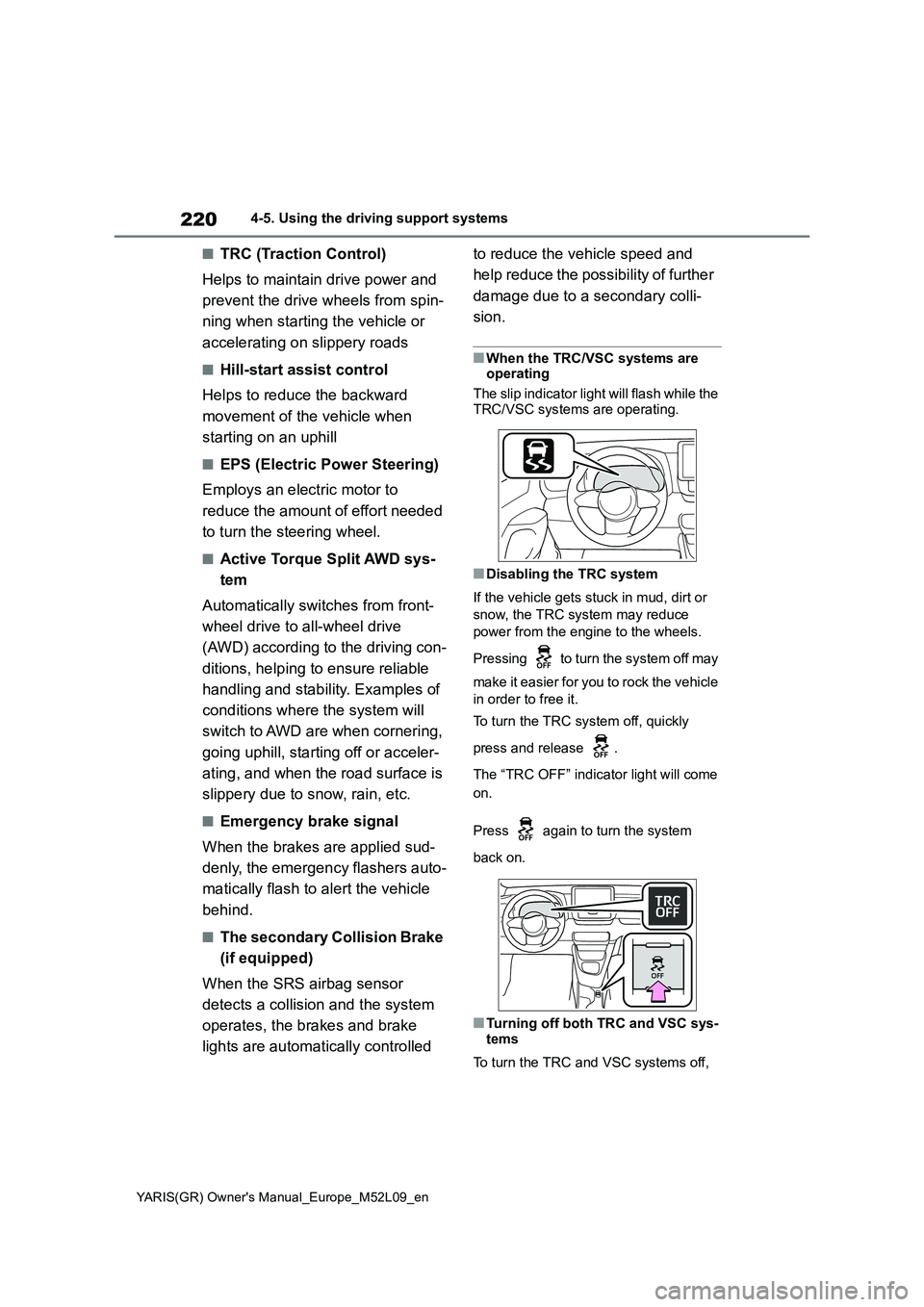
220
YARIS(GR) Owner's Manual_Europe_M52L09_en
4-5. Using the driving support systems
■TRC (Traction Control)
Helps to maintain drive power and
prevent the drive wheels from spin-
ning when starting the vehicle or
accelerating on slippery roads
■Hill-start assist control
Helps to reduce the backward
movement of the vehicle when
starting on an uphill
■EPS (Electric Power Steering)
Employs an electric motor to
reduce the amount of effort needed
to turn the steering wheel.
■Active Torque Split AWD sys-
tem
Automatically switches from front-
wheel drive to all-wheel drive
(AWD) according to the driving con-
ditions, helping to ensure reliable
handling and stability. Examples of
conditions where the system will
switch to AWD are when cornering,
going uphill, starting off or acceler-
ating, and when the road surface is
slippery due to snow, rain, etc.
■Emergency brake signal
When the brakes are applied sud-
denly, the emergency flashers auto-
matically flash to alert the vehicle
behind.
■The secondary Collision Brake
(if equipped)
When the SRS airbag sensor
detects a collision and the system
operates, the brakes and brake
lights are automatically controlled to reduce the vehicle speed and
help reduce the possibility of further
damage due to a secondary colli-
sion.
■When the TRC/VSC systems are
operating
The slip indicator light will flash while the
TRC/VSC systems are operating.
■Disabling the TRC system
If the vehicle gets stuck in mud, dirt or
snow, the TRC system may reduce
power from the engine to the wheels.
Pressing to turn the system off may
make it easier for you to rock the vehicle
in order to free it.
To turn the TRC system off, quickly
press and release .
The “TRC OFF” indicator light will come
on.
Press again to turn the system
back on.
■Turning off both TRC and VSC sys-
tems
To turn the TRC and VSC systems off,
Page 223 of 458
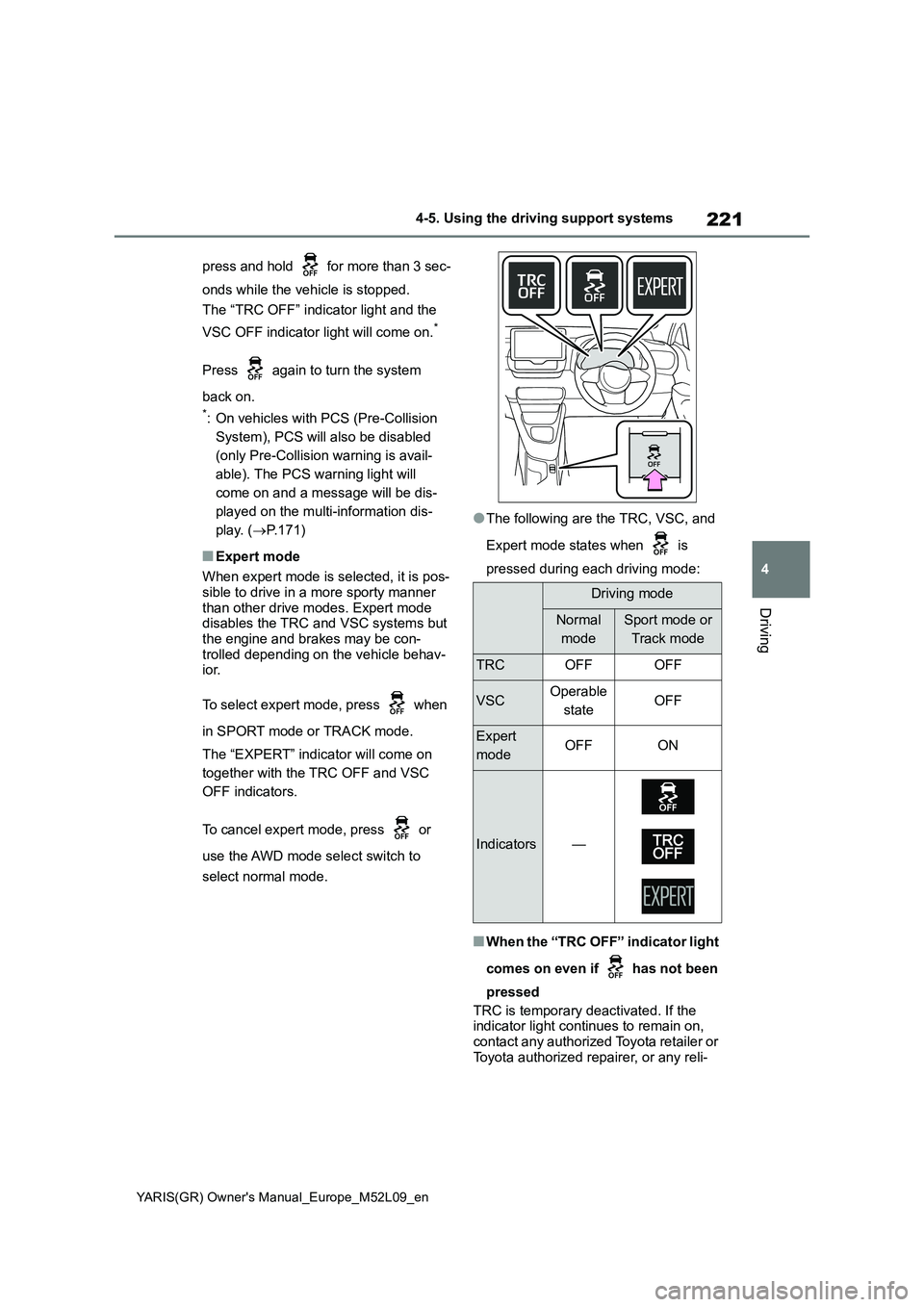
221
4
YARIS(GR) Owner's Manual_Europe_M52L09_en
4-5. Using the driving support systems
Driving
press and hold for more than 3 sec-
onds while the vehicle is stopped.
The “TRC OFF” indicator light and the
VSC OFF indicator light will come on.
*
Press again to turn the system
back on.
*: On vehicles with PCS (Pre-Collision
System), PCS will also be disabled
(only Pre-Collision warning is avail-
able). The PCS warning light will
come on and a message will be dis-
played on the multi-information dis-
play. (→P.171)
■Expert mode
When expert mode is selected, it is pos-
sible to drive in a more sporty manner
than other drive modes. Expert mode
disables the TRC and VSC systems but
the engine and brakes may be con-
trolled depending on the vehicle behav-
ior.
To select expert mode, press when
in SPORT mode or TRACK mode.
The “EXPERT” indicator will come on
together with the TRC OFF and VSC
OFF indicators.
To cancel expert mode, press or
use the AWD mode select switch to
select normal mode.
●The following are the TRC, VSC, and
Expert mode states when is
pressed during each driving mode:
■When the “TRC OFF” indicator light
comes on even if has not been
pressed
TRC is temporary deactivated. If the
indicator light continues to remain on,
contact any authorized Toyota retailer or
Toyota authorized repairer, or any reli-
Driving mode
Normal
modeSport mode or
Track mode
TRCOFFOFF
VSCOperable
stateOFF
Expert
modeOFFON
Indicators—
Page 229 of 458
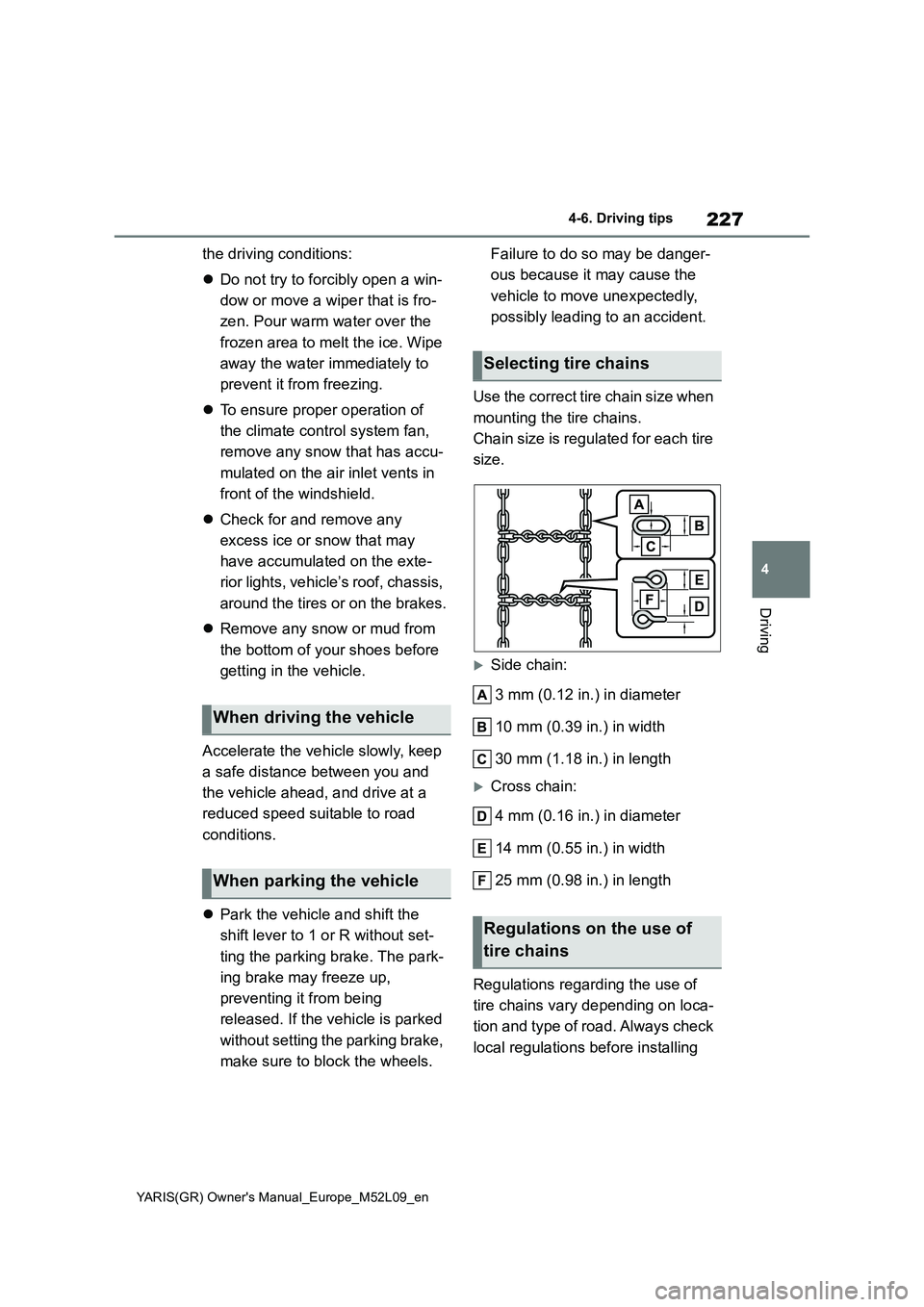
227
4
YARIS(GR) Owner's Manual_Europe_M52L09_en
4-6. Driving tips
Driving
the driving conditions:
�zDo not try to forcibly open a win-
dow or move a wiper that is fro-
zen. Pour warm water over the
frozen area to melt the ice. Wipe
away the water immediately to
prevent it from freezing.
�zTo ensure proper operation of
the climate control system fan,
remove any snow that has accu-
mulated on the air inlet vents in
front of the windshield.
�zCheck for and remove any
excess ice or snow that may
have accumulated on the exte-
rior lights, vehicle’s roof, chassis,
around the tires or on the brakes.
�zRemove any snow or mud from
the bottom of your shoes before
getting in the vehicle.
Accelerate the vehicle slowly, keep
a safe distance between you and
the vehicle ahead, and drive at a
reduced speed suitable to road
conditions.
�zPark the vehicle and shift the
shift lever to 1 or R without set-
ting the parking brake. The park-
ing brake may freeze up,
preventing it from being
released. If the vehicle is parked
without setting the parking brake,
make sure to block the wheels.Failure to do so may be danger-
ous because it may cause the
vehicle to move unexpectedly,
possibly leading to an accident.
Use the correct tire chain size when
mounting the tire chains.
Chain size is regulated for each tire
size.
Side chain:
3 mm (0.12 in.) in diameter
10 mm (0.39 in.) in width
30 mm (1.18 in.) in length
Cross chain:
4 mm (0.16 in.) in diameter
14 mm (0.55 in.) in width
25 mm (0.98 in.) in length
Regulations regarding the use of
tire chains vary depending on loca-
tion and type of road. Always check
local regulations before installing
When driving the vehicle
When parking the vehicle
Selecting tire chains
Regulations on the use of
tire chains
Page 251 of 458
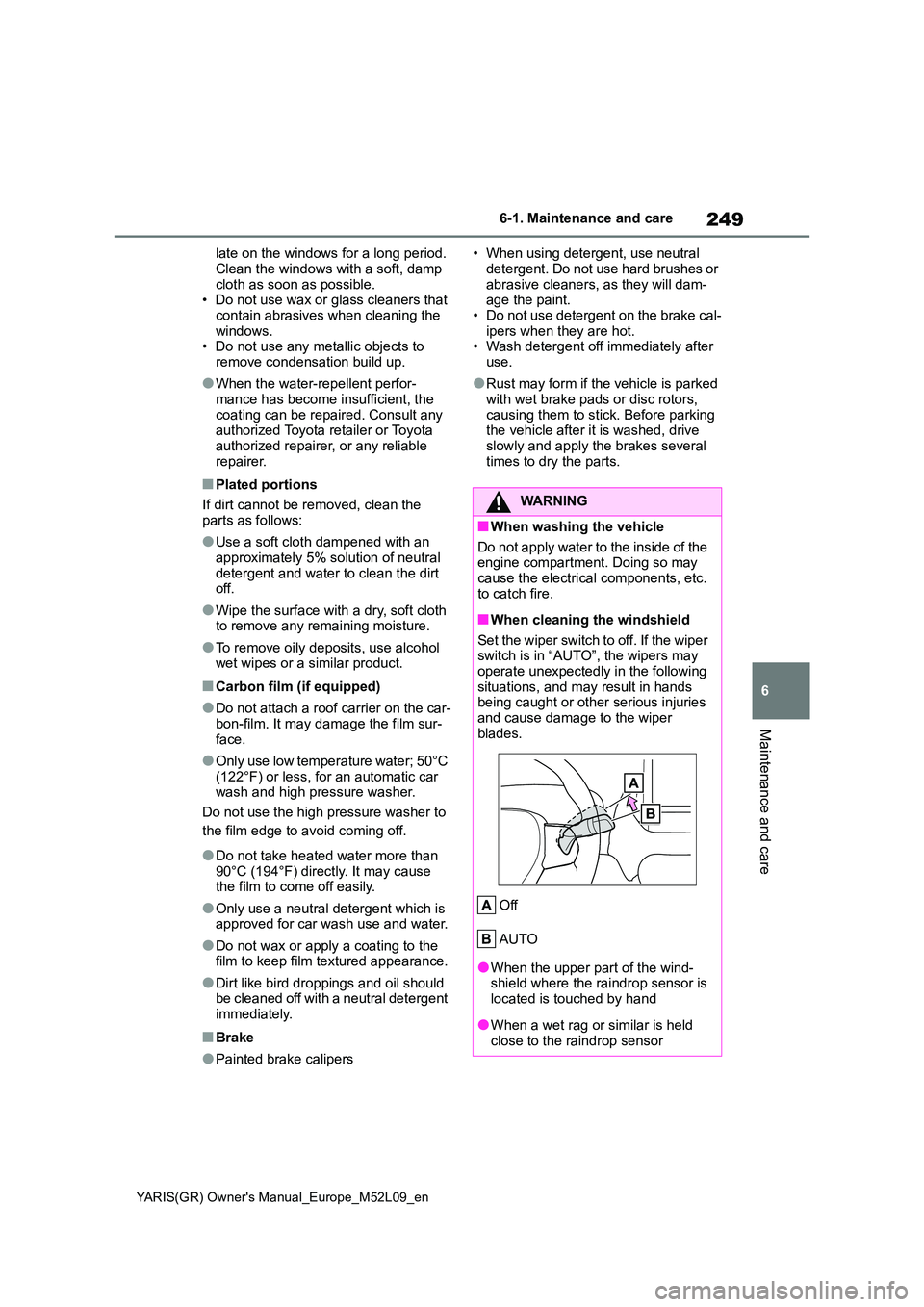
249
6
YARIS(GR) Owner's Manual_Europe_M52L09_en
6-1. Maintenance and care
Maintenance and care
late on the windows for a long period.
Clean the windows with a soft, damp cloth as soon as possible.• Do not use wax or glass cleaners that
contain abrasives when cleaning the windows.• Do not use any metallic objects to
remove condensation build up.
●When the water-repellent perfor-
mance has become insufficient, the coating can be repaired. Consult any authorized Toyota retailer or Toyota
authorized repairer, or any reliable repairer.
■Plated portions
If dirt cannot be removed, clean the
parts as follows:
●Use a soft cloth dampened with an
approximately 5% solution of neutral detergent and water to clean the dirt off.
●Wipe the surface with a dry, soft cloth to remove any remaining moisture.
●To remove oily deposits, use alcohol wet wipes or a similar product.
■Carbon film (if equipped)
●Do not attach a roof carrier on the car-bon-film. It may damage the film sur-
face.
●Only use low temperature water; 50°C
(122°F) or less, for an automatic car wash and high pressure washer.
Do not use the high pressure washer to
the film edge to avoid coming off.
●Do not take heated water more than 90°C (194°F) directly. It may cause the film to come off easily.
●Only use a neutral detergent which is approved for car wash use and water.
●Do not wax or apply a coating to the film to keep film textured appearance.
●Dirt like bird droppings and oil should be cleaned off with a neutral detergent
immediately.
■Brake
●Painted brake calipers
• When using detergent, use neutral
detergent. Do not use hard brushes or abrasive cleaners, as they will dam-age the paint.
• Do not use detergent on the brake cal- ipers when they are hot.• Wash detergent off immediately after
use.
●Rust may form if the vehicle is parked
with wet brake pads or disc rotors, causing them to stick. Before parking the vehicle after it is washed, drive
slowly and apply the brakes several times to dry the parts.
WARNING
■When washing the vehicle
Do not apply water to the inside of the engine compartment. Doing so may cause the electrical components, etc.
to catch fire.
■When cleaning the windshield
Set the wiper switch to off. If the wiper switch is in “AUTO”, the wipers may operate unexpectedly in the following
situations, and may result in hands being caught or other serious injuries and cause damage to the wiper
blades.
Off
AUTO
●When the upper part of the wind- shield where the raindrop sensor is
located is touched by hand
●When a wet rag or similar is held
close to the raindrop sensor
Page 291 of 458
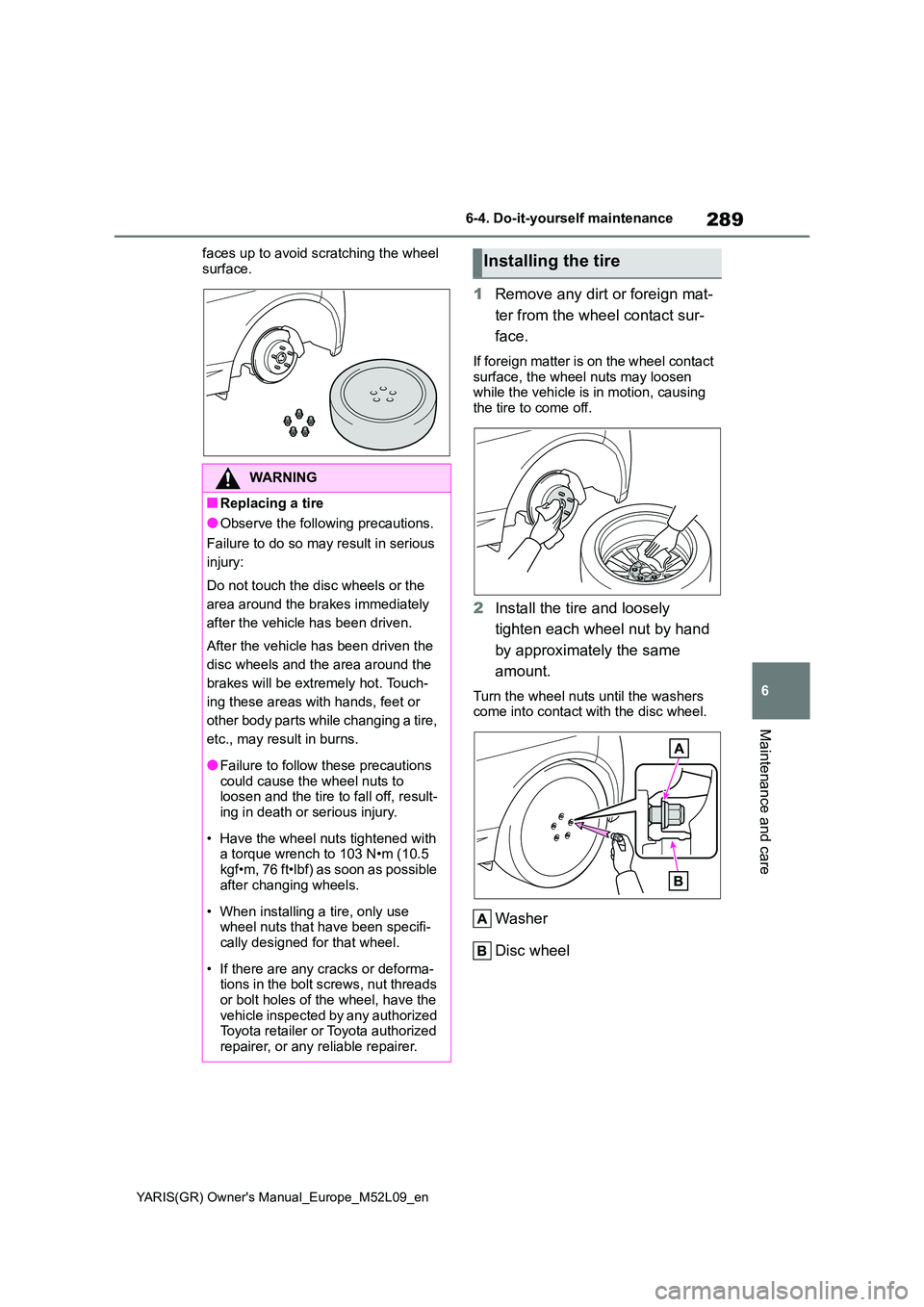
289
6
YARIS(GR) Owner's Manual_Europe_M52L09_en
6-4. Do-it-yourself maintenance
Maintenance and care
faces up to avoid scratching the wheel
surface.
1 Remove any dirt or foreign mat-
ter from the wheel contact sur-
face.
If foreign matter is on the wheel contact
surface, the wheel nuts may loosen while the vehicle is in motion, causing the tire to come off.
2 Install the tire and loosely
tighten each wheel nut by hand
by approximately the same
amount.
Turn the wheel nuts until the washers come into contact with the disc wheel.
Washer
Disc wheel
WARNING
■Replacing a tire
●Observe the following precautions.
Failure to do so may result in serious
injury:
Do not touch the disc wheels or the
area around the brakes immediately
after the vehicle has been driven.
After the vehicle has been driven the
disc wheels and the area around the
brakes will be extremely hot. Touch-
ing these areas with hands, feet or
other body parts while changing a tire,
etc., may result in burns.
●Failure to follow these precautions
could cause the wheel nuts to loosen and the tire to fall off, result-ing in death or serious injury.
• Have the wheel nuts tightened with a torque wrench to 103 N•m (10.5
kgf•m, 76 ft•lbf) as soon as possible after changing wheels.
• When installing a tire, only use wheel nuts that have been specifi-cally designed for that wheel.
• If there are any cracks or deforma- tions in the bolt screws, nut threads
or bolt holes of the wheel, have the vehicle inspected by any authorized Toyota retailer or Toyota authorized
repairer, or any reliable repairer.
Installing the tire
Page 309 of 458
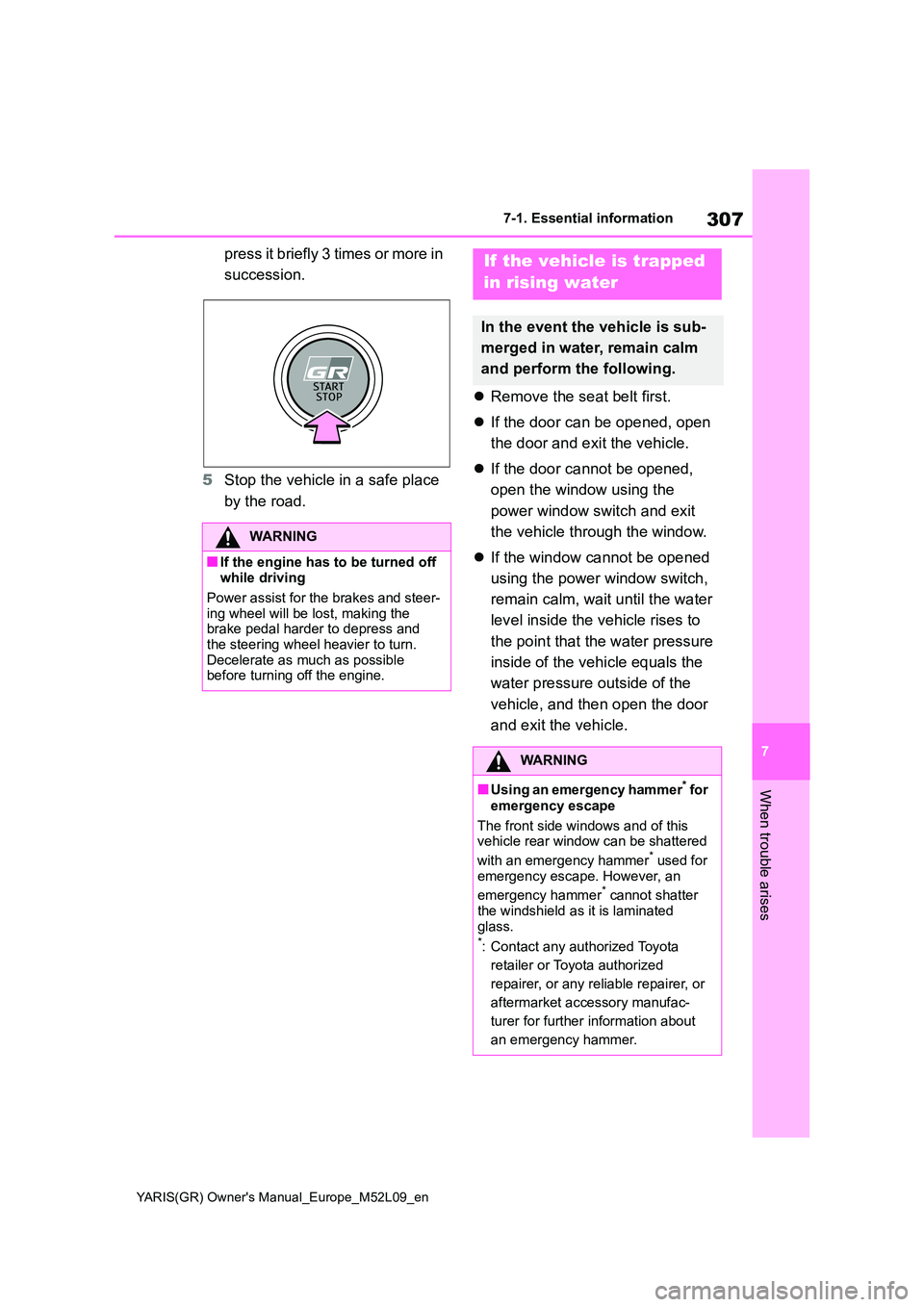
307
7
YARIS(GR) Owner's Manual_Europe_M52L09_en
7-1. Essential information
When trouble arises
press it briefly 3 times or more in
succession.
5 Stop the vehicle in a safe place
by the road.
�z Remove the seat belt first.
�z If the door can be opened, open
the door and exit the vehicle.
�z If the door cannot be opened,
open the window using the
power window switch and exit
the vehicle through the window.
�z If the window cannot be opened
using the power window switch,
remain calm, wait until the water
level inside the vehicle rises to
the point that the water pressure
inside of the vehicle equals the
water pressure outside of the
vehicle, and then open the door
and exit the vehicle.
WARNING
■If the engine has to be turned off while driving
Power assist for the brakes and steer-
ing wheel will be lost, making the brake pedal harder to depress and the steering wheel heavier to turn.
Decelerate as much as possible before turning off the engine.
If the vehicle is trapped
in rising water
In the event the vehicle is sub-
merged in water, remain calm
and perform the following.
WARNING
■Using an emergency hammer* for
emergency escape
The front side windows and of this vehicle rear window can be shattered
with an emergency hammer* used for emergency escape. However, an
emergency hammer* cannot shatter
the windshield as it is laminated glass.*: Contact any authorized Toyota
retailer or Toyota authorized
repairer, or any reliable repairer, or
aftermarket accessory manufac-
turer for further information about
an emergency hammer.
Page 313 of 458
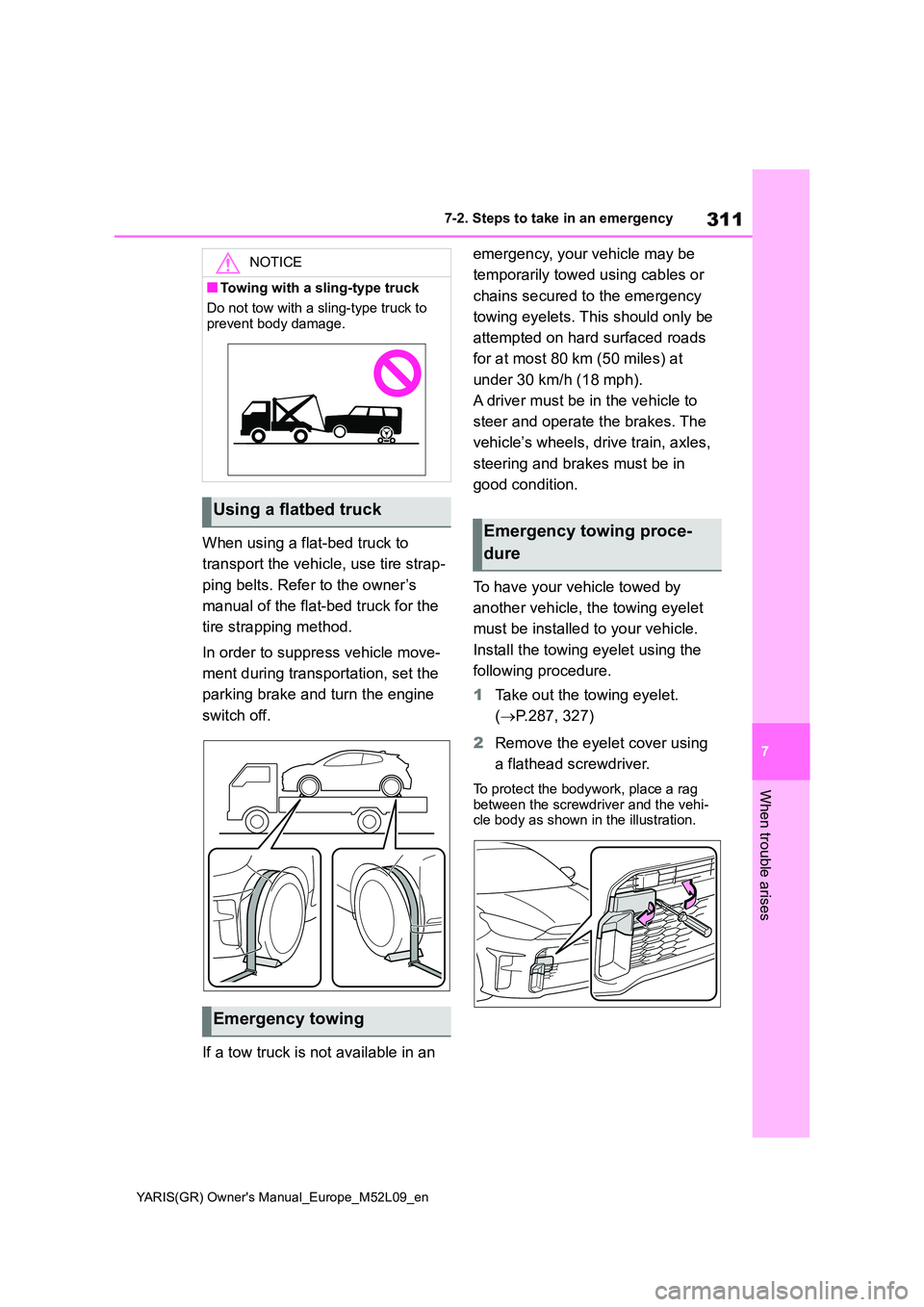
311
7
YARIS(GR) Owner's Manual_Europe_M52L09_en
7-2. Steps to take in an emergency
When trouble arises
When using a flat-bed truck to
transport the vehicle, use tire strap-
ping belts. Refer to the owner’s
manual of the flat-bed truck for the
tire strapping method.
In order to suppress vehicle move-
ment during transportation, set the
parking brake and turn the engine
switch off.
If a tow truck is not available in an
emergency, your vehicle may be
temporarily towed using cables or
chains secured to the emergency
towing eyelets. This should only be
attempted on hard surfaced roads
for at most 80 km (50 miles) at
under 30 km/h (18 mph).
A driver must be in the vehicle to
steer and operate the brakes. The
vehicle’s wheels, drive train, axles,
steering and brakes must be in
good condition.
To have your vehicle towed by
another vehicle, the towing eyelet
must be installed to your vehicle.
Install the towing eyelet using the
following procedure.
1 Take out the towing eyelet.
( →P.287, 327)
2 Remove the eyelet cover using
a flathead screwdriver.
To protect the bodywork, place a rag
between the screwdriver and the vehi- cle body as shown in the illustration.
NOTICE
■Towing with a sling-type truck
Do not tow with a sling-type truck to
prevent body damage.
Using a flatbed truck
Emergency towing
Emergency towing proce-
dure